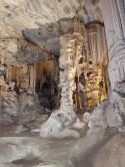My computer is on the fritz so I’m using one at the hotel where I am staying–the aptly named Turbine Hotel. It’s aptly named because it is a converted power station; in fact, if I glance up from my computer, I gaze at the speed reducer the renovators left in place. If I look to the right, out the door, there is a 1926 racer parked, awaiting the weekend’s hill climb (It looks like something I saw in the Speedway museum). If I look farther out the door, I can see the lagoon at Kynysa, which opens into the Indian Ocean.

 In other words, I’ve gone from the mountain-desert to the sea, climbing over a 3000 foot pass (that’s 800 meters here). While in the mountains, we stopped at the largest commercial cave in South Africa, the Cango Cave, with huge rooms and ample passages, a real comfort to a claustrophobic Scoutmaster. The oldest feature is 1 1/2 million years old, so it was nice not to be the oldest in the room! My guide said she’d been here years ago, before the floor was leveled and steps were put in, and I imagine it was closer to Illinois Caverns than to the more commercial caves we’ve been to. The cave is four miles long, but we went about half a mile. There’s a more “adventurous” stretch, but when I saw the size of the entrance, I thought, “Not yet.”
In other words, I’ve gone from the mountain-desert to the sea, climbing over a 3000 foot pass (that’s 800 meters here). While in the mountains, we stopped at the largest commercial cave in South Africa, the Cango Cave, with huge rooms and ample passages, a real comfort to a claustrophobic Scoutmaster. The oldest feature is 1 1/2 million years old, so it was nice not to be the oldest in the room! My guide said she’d been here years ago, before the floor was leveled and steps were put in, and I imagine it was closer to Illinois Caverns than to the more commercial caves we’ve been to. The cave is four miles long, but we went about half a mile. There’s a more “adventurous” stretch, but when I saw the size of the entrance, I thought, “Not yet.”
The cave once let people in on their own; the consequence is a number of cut off stalactites and stalagmites. The sad thing about it (besides the fact that it takes thousands of years to grow, and would require a change in the climate) is that the calcium base turns to sand and crumbles (eventually) when out of the humid temperature of the cave.
As we got closer to the coast, of course, the vegetation changed; it’s heavily forested, and we’re supposed to go to a national park/forest today if it doesn’t rain too heavily.
 Kynysa and its sister city, about 30 km away, (we went there to view the splendid beach on the Indian Ocean) resemble any port city where people come to enjoy the views on what everyone in the world (except maybe the US) calls “holiday”, with the tacky shops and the wonderful restaurants and marinas. My guide said the sister city in particular has a lot of weekend homes–it’s only four or five hours from Cape Town–for really rich South Africans.
Kynysa and its sister city, about 30 km away, (we went there to view the splendid beach on the Indian Ocean) resemble any port city where people come to enjoy the views on what everyone in the world (except maybe the US) calls “holiday”, with the tacky shops and the wonderful restaurants and marinas. My guide said the sister city in particular has a lot of weekend homes–it’s only four or five hours from Cape Town–for really rich South Africans.
As is true of most developing countries, though, there are nearby slums that resemble poorer versions of the favelas I saw last year in Brazil–wooden boxes basically with corrugated roofs. Above them frequently are square but solid houses that are built by the government. My guide said that when people move into the houses, the shanties get immediately occupied by newcomers. The easy immigration into South Africa, which is more prosperous than most of its neighbors, combined with the slowdown of the economy, has created tensions that have erupted in some of the cities, especially Durban on the east coast.
All is quiet here, awaiting, I suspect, the arrival of more racing cars. By that time, I expect we’ll be heading slowly back to Cape Town. In the meantime, I’ve switched from ostrich to oysters–at least they both begin with an “o”, and meals overlooking the sea. Not a bad variant.
Good morning to you all.